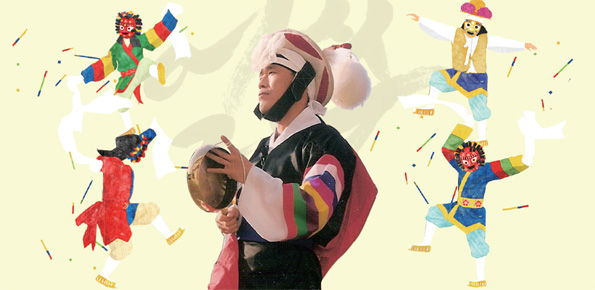What do you think about pungmul? Pungmul is a traditional Korean music which uses gongs, janggus, drums, jings, and tabors. Nongak and gut are similar to pungmul. Nongak is music played to lift people’s spirits when working or during holidays in farm villages. Gut is music used to pray for the peace and harmony of a village and is accompanied by dancing to the beat and the locals interacting with each other. Today, we meet Yang Jin-sung, who leads the Imsil Pilbong Nongak Preservation Association, which is designated as a State-Designated Cultural Property and a UNESCO World Heritage Property. -Ed
Q1. Can you explain about the Preservation Association?
Pilbong nongak is a living culture which started in Pilbong and became a nucleus of the community. In the past, people who made nongak and people who enjoyed nongak shared it together in Pilbong, so it was designated as Pilbong nongak. Traditional music like this should have survived, but it did not. Therefore, young people who live in the village made the Preservation Association. In the association, Yang Sun-yong played a key role to try to preserve it. The association plays Daeboreum gut on the day of the first full moon of the Lunar New Year and teaches pungmul to college youths through the Pilbong Nongak Training Center. Also, when we forget something about our ancestors’ pungmul, we seek advice from adults who lived in that time to restore it. In short, the association includes all of the people who know the value of pungmul, and we work together to promote its development.
Q2. What is your favorite performance among your performances?
My favorite performance is the Daeboreum gut, which is performed by the association and the Pilbong people together once a year. At that time, thousands of people, including people who like Pilbong nongak and traditional culture lovers who want to see it, come and enjoy pungmul. This is the 38th anniversary this year, and it is significant that I capture and sustain the affection of the teachers who waited for audiences with impatience 38 years ago. But above all, I play this performance with affection because there are many people who came from all over the country to enjoy the performance. There is one more performance that I have affection for. It is the Pilbong Gut Festival. The Pilbong Gut Festival was started to commemorate Yang Sun-yong. At first, it was a memorial ceremony, but nowadays it has become a festival where people who play pungmul come together from all over the country and enjoy the performance. I think these two performances are the most important things for me in a year.
Q3. Even though pungmul is unfamiliar to much of the public,
I think the answer is the people. Also, the music culture has continuously been embraced in the moment. And thanks to the people who recognized the importance of this culture and tried to maintain it, our culture will be able to continue. Some cultures that we label as traditional now are not just a trend; they are official cultures of our nation. Therefore, I think anyone who lives in this land needs to experience and feel this culture just once. In addition to our national history and Korean language, gukak needs to be a mandatory subject in school. I think gukak, Korean traditional music, could be a competitive edge of Korea in the world. However, it is not. College students experienced pungmul, a kind of gukak, and reflected on our culture, and then the pungmul band was developed by them step by step. Thanks to them, now more people can experience it and play pungmul. Now, pungmul has been designated as a UNESCO World Heritage.
Q4. What does pungmul mean to the people?
The biggest meaning that pungmul has is to bring Koreans together. The principles of coexistence and sharing are the values of human life that we should never lose. I think pungmul can give energy that helps people think about and practice these values. There are many shared cultures in places where people live together. Those can be enjoyed by oneself, with family or with a peer group. I think pungmul is the only culture where a variety of people can embrace the moment. These are the meaningful values that pungmul has. I hope that many people will learn these values.
Q5. What do you want students to learn through the Pilbong Nongak Training Center?
As a senior member of the pungmul band, I feel proud that students try to learn pungmul with passion. This is because young people preserved traditional cultures after learning and experiencing their parents’ cultures firsthand. Therefore, it is very meaningful that students come to the Pilbong Nongak Training Center and learn pungmul. Many college students do part-time jobs or study during vacation. However, without passion and affection, it is difficult to visit the training center in order to learn traditional culture during their vacation. Most of all, I want to applaud the students who visit the training center. In addition, what I want to ask is for students to think of pungmul as more valuable. Also, I hope the students who continue pungmul will be more dedicated and remember their purpose. Training in pungmul will be hard, but I hope the students will gain many things from training. Then, based on what they learn here, the students will develop more outside the training center.
By Jo Se-in l si38@cbnu.ac.kr
By Min Byung-woo l bw38@cbnu.ac.kr



 All
All People
People






 Jo Se-in & Min Byung-woo
Jo Se-in & Min Byung-woo











